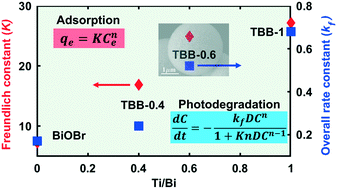Mesoporous TiO2–BiOBr microspheres with tailorable adsorption capacities for photodegradation of organic water pollutants: probing adsorption–photocatalysis synergy by combining experiments and kinetic modeling†
Abstract
Understanding the adsorption–photocatalysis synergy helps advance solar-driven photodegradation of organic wastewater pollutants. To evaluate the synergy, mesoporous TiO2(amorphous)–BiOBr microspheres were facilely synthesized as model photocatalysts and characterized by XRD, SEM, TEM/HRTEM, XPS, nitrogen adsorption–desorption, UV-vis DRS, photoluminescence, and FTIR. The characterizations and photodegradation tests suggested that the composites had both adsorption sites and photocatalysis sites on the BiOBr phase, while homogeneously distributed TiO2 in BiOBr microplates tailored the size of BiOBr crystallites. Accordingly, the surface areas of the composites spanned from 22 to 155 m2 g−1 and the adsorption capacities for methyl orange (MO) ranged from 16 to 54 mg g−1, controlled by the TiO2 content. In addition to experiments, kinetic modeling that combined adsorption with photocatalysis was developed and aided in elucidating the synergy and quantitatively evaluating the composites with extracted rate constants from experimental data. The rate constant of the composite (Ti/Bi = 0.6) was calculated to be 3 times that of the pure BiOBr. Though adsorption promoted MO photodegradation, the capacity of the composite for MO adsorption and photodegradation decreased dramatically during the cycling tests. Nevertheless, this problem did not happen during photodegradation of rhodamine B and phenol on the composite and photodegradation of MO on pure BiOBr. This was explained by the possible accumulation of degradation intermediates on the composite surface. This study provides a useful approach to investigate the adsorption–photocatalysis synergy from the perspectives of experiments and kinetic modeling and implies the necessity of scrutinizing the adverse effects of high levels of adsorption on the recyclability of photocatalysts.



 Please wait while we load your content...
Please wait while we load your content...